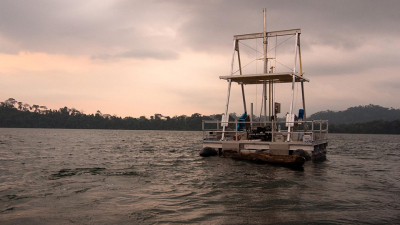- Home
- Discover
- Archive News
- News 2018
- rain forest crisis
Humans caused rain forest crisis in Central Africa 2600 years ago

In 2014, the team around Dr. Yannick Garcin from the University of Potsdam retrieved new sediment cores from Lake Barombi in southern Cameroon and examined them with the newest methods. “We have a clear record of the rain forest crisis evidenced by pollen and the isotopic composition of plant remains,” says Dr. Lydie Dupont from MARUM – Center for Marine Environmental Sciences of the University of Bremen. “However, the isotopic composition does not show any change in rainfall during the period,” adds Dr. Enno Schefuß, also from MARUM. Archaeological data solved the mystery. A compilation of archaeological findings from the region, such as fireplaces, potsherds and signs of iron smelting, demonstrated a rapid increase in population density and human activities 2600 years ago. Yet, as soon as population density decreased again around 2000 years ago, the rain forest came back quickly. Only the geological record documents the human footprint on the Central African rain forest.
Original publication:
Yannick Garcin, Pierre Deschamps, Guillemette Ménot, Geoffroy de Saulieu, Enno Schefuß, David Sebag, Lydie M. Dupont, Richard Oslisly, Brian Brademann, Kevin G. Mbusnum, Jean-Michel Onana, Andrew A. Ako, Laura S. Epp, Rik Tjallingii, Manfred R. Strecker, Achim Brauer and Dirk Sachse. (2018). Early anthropogenic impact on Western Central African rainforests 2,600 y ago. PNAS. DOI: 10.1073/pnas.1715336115
Participating Institutes:
University of Potsdam, Germany; CEREGE – IRD, Aix-Marseille Université, France; Université de Lyon, Ens de Lyon, France; MARUM – Center for Marine Environmental Sciences, University of Bremen, Germany; PALOC – IRD, France; UNIROUEN, UNICAEN, France; GFZ German Research Centre for Geosciences, Potsdam, Germany; LCE, Aix-Marseille Université, France; University of Yaoundé I, Cameroon; IRGM, Cameroon; Alfred Wegener Institute, Potsdam, Germany.
Contact:
Dr. Enno Schefuß
Phone: +49 421 218 65526
E-Mail: [Bitte aktivieren Sie Javascript]
Dr. Lydie Dupont
Phone: +49 421 218 65532
E-Mail: [Bitte aktivieren Sie Javascript]
Ulrike Prange
MARUM public relation
Phone: +49 421 218 65540
Email: [Bitte aktivieren Sie Javascript]


